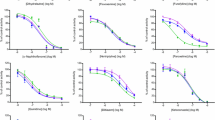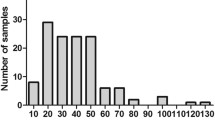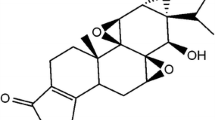Abstract
Purpose
Monoamine oxidases (MAOs) are non-CYP enzymes that contribute to systemic elimination of therapeutic agents, and localized on mitochondrial membranes. The aim of the present study was to validate quantitative estimation of metabolic clearance of MAO substrate drugs using human liver microsomes (HLMs).
Methods
Three MAO substrate drugs, sumatriptan, rizatriptan and phenylephrine, as well as four CYP substrates were selected, and their disappearance during incubation with HLMs or mitochondria (HLMt) was measured. Metabolic clearance (CL) was then calculated from the disappearance curve.
Results
CL obtained in HLMs for sumatriptan and a typical MAO substrate serotonin was correlated with that obtained in HLMt among ten human individual livers. Hepatic intrinsic clearance (CLint,vitro) estimated from CL in HLMs was 14–20 and 2–5 times lower than in vivo hepatic intrinsic clearance (CLint,vivo) obtained from literature for MAO and CYP substrates, respectively. Utilization of HLMs for quantitatively assessing metabolic clearance of MAO substrates was further validated by proteomics approach which has revealed that numerous proteins localized on inner and outer membranes of mitochondria were detected in both HLMs and HLMt.
Conclusion
CLint,vitro values of MAO substrate drugs can be quantitatively estimated with HLMs and could be used for semi-quantitative prediction of CLint,vivo values.







Similar content being viewed by others
Abbreviations
- CL:
-
In vitro metabolic clearance
- CLint :
-
Intrinsic clearance
- CYP:
-
Cytochrome P450
- HLMs:
-
Human liver microsomes
- HLMt:
-
Human liver mitochondria
- IVIVE:
-
In vitro-in vivo extrapolation
- LC-MS/MS:
-
Liquid chromatography-mass spectrometry/mass spectrometry
- MAO:
-
Monoamine oxidase
- NADPH:
-
Nicotinamide adenine dinucleotide phosphate
References
Chiba M, Ishii Y, Sugiyama Y. Prediction of hepatic clearance in human from in vitro data for successful drug development. AAPS J. 2009;11(2):262–76.
Pryde DC, Dalvie D, Hu Q, Jones P, Obach RS, Tran TD. Aldehyde oxidase: an enzyme of emerging importance in drug discovery. J Med Chem. 2010;53(24):8441–60.
Brandon EF, Raap CD, Meijerman I, Beijnen JH, Schellens JH. An update on in vitro test methods in human hepatic drug biotransformation research: pros and cons. Toxicol Appl Pharmacol. 2003;189(3):233–46.
Kilford PJ, Stringer R, Sohal B, Houston JB, Galetin A. Prediction of drug clearance by glucuronidation from in vitro data: use of combined cytochrome P450 and UDP-glucuronosyltransferase cofactors in alamethicin-activated human liver microsomes. Drug Metab Dispos. 2009;37(1):82–9.
Miners JO, Knights KM, Houston JB, Mackenzie PI. In vitro-in vivo correlation for drugs and other compounds eliminated by glucuronidation in humans: pitfalls and promises. Biochem Pharmacol. 2006;71(11):1531–9.
Akabane T, Gerst N, Masters JN, Tamura K. A quantitative approach to hepatic clearance prediction of metabolism by aldehyde oxidase using custom pooled hepatocytes. Xenobiotica. 2012;42(9):863–71.
Strolin Benedetti M, Whomsley R, Baltes E. Involvement of enzymes other than CYPs in the oxidative metabolism of xenobiotics. Expert Opin Drug Metab Toxicol. 2006;2(6):895–921.
Berry MD, Juorio AV, Paterson IA. The functional role of monoamine oxidases a and B in the mammalian central nervous system. Prog Neurobiol. 1994;42(3):375–91.
Saura J, Nadal E, van den Berg B, Vila M, Bombi JA, Mahy N. Localization of monoamine oxidases in human peripheral tissues. Life Sci. 1996;59(16):1341–9.
Shih JC, Chen K, Ridd MJ. Monoamine oxidase: from genes to behavior. Annu Rev Neurosci. 1999;22:197–217.
Kamel A, Colizza K, Gunduz M, Harriman S, Obach RS. In vitro-in vivo correlation for intrinsic clearance for CP-409,092 and sumatriptan: a case study to predict the in vivo clearance for compounds metabolized by monoamine oxidase. Xenobiotica. 2012;42(4):355–62.
Dixon CM, Park GR, Tarbit MH. Characterization of the enzyme responsible for the metabolism of sumatriptan in human liver. Biochem Pharmacol. 1994;47(7):1253–7.
Iwasa T, Sano H, Sugiura A, Uchiyama N, Hara K, Okochi H, et al. An in vitro interethnic comparison of monoamine oxidase activities between Japanese and Caucasian livers using rizatriptan, a serotonin receptor 1B/1D agonist, as a model drug. Br J Clin Pharmacol. 2003;56(5):537–44.
Yu AM, Granvil CP, Haining RL, Krausz KW, Corchero J, Kupfer A, et al. The relative contribution of monoamine oxidase and cytochrome p450 isozymes to the metabolic deamination of the trace amine tryptamine. J Pharmacol Exp Ther. 2003;304(2):539–46.
Zientek M, Jiang Y, Youdim K, Obach RS. In vitro-in vivo correlation for intrinsic clearance for drugs metabolized by human aldehyde oxidase. Drug Metab Dispos. 2010;38(8):1322–7.
Ito K, Houston JB. Prediction of human drug clearance from in vitro and preclinical data using physiologically based and empirical approaches. Pharm Res. 2005;22(1):103–12.
Ciraulo DA, Barnhill JG, Jaffe JH. Clinical pharmacokinetics of imipramine and desipramine in alcoholics and normal volunteers. Clin Pharmacol Ther. 1988;43(5):509–18.
Dixon CM, Saynor DA, Andrew PD, Oxford J, Bradbury A, Tarbit MH. Disposition of sumatriptan in laboratory animals and humans. Drug Metab Dispos. 1993;21(5):761–9.
Vyas KP, Halpin RA, Geer LA, Ellis JD, Liu L, Cheng H, et al. Disposition and pharmacokinetics of the antimigraine drug, rizatriptan, in humans. Drug Metab Dispos. 2000;28(1):89–95.
Milton KA, Scott NR, Allen MJ, Abel S, Jenkins VC, James GC, et al. Pharmacokinetics, pharmacodynamics, and safety of the 5-HT(1B/1D) agonist eletriptan following intravenous and oral administration. J Clin Pharmacol. 2002;42(5):528–39.
Sogaard B, Mengel H, Rao N, Larsen F. The pharmacokinetics of escitalopram after oral and intravenous administration of single and multiple doses to healthy subjects. J Clin Pharmacol. 2005;45(12):1400–6.
Sandrini G, Perrotta A, Tassorelli C, Nappi G. Eletriptan. Expert Opin Drug Metab Toxicol. 2009;5(12):1587–98.
Mandrioli R, Mercolini L, Raggi MA. Evaluation of the pharmacokinetics, safety and clinical efficacy of sertraline used to treat social anxiety. Expert Opin Drug Metab Toxicol. 2013;9(11):1495–505.
Tfelt-Hansen P, Hougaard A. Sumatriptan: a review of its pharmacokinetics, pharmacodynamics and efficacy in the acute treatment of migraine. Expert Opin Drug Metab Toxicol. 2013;9(1):91–103.
Janin A, Monnet J. Bioavailability of paracetamol, phenylephrine hydrochloride and guaifenesin in a fixed-combination syrup versus an oral reference product. The Journal of International Medical Research. 2014;42(2):347–59.
Iwatsubo T, Hirota N, Ooie T, Suzuki H, Sugiyama Y. Prediction of in vivo drug disposition from in vitro data based on physiological pharmacokinetics. Biopharm Drug Dispos. 1996;17(4):273–310.
Uetsuka S, Ogata G, Nagamori S, Isozumi N, Nin F, Yoshida T, et al. Molecular architecture of the stria vascularis membrane transport system, which is essential for physiological functions of the mammalian cochlea. Eur J Neurosci. 2015;42(3):1984–2002.
Masuda T, Tomita M, Ishihama Y. Phase transfer surfactant-aided trypsin digestion for membrane proteome analysis. J Proteome Res. 2008;7(2):731–40.
Rappsilber J, Mann M, Ishihama Y. Protocol for micro-purification, enrichment, pre-fractionation and storage of peptides for proteomics using StageTips. Nat Protoc. 2007;2(8):1896–906.
Silva JC, Gorenstein MV, Li GZ, Vissers JP, Geromanos SJ. Absolute quantification of proteins by LCMSE: a virtue of parallel MS acquisition. Mol Cell Proteomics. 2006;5(1):144–56.
Ferrari A, Sternieri E, Ferraris E, Bertolini A. Emerging problems in the pharmacology of migraine: interactions between triptans and drugs for prophylaxis. Pharmacol Res. 2003;48(1):1–9.
Evans DC, O'Connor D, Lake BG, Evers R, Allen C, Hargreaves R. Eletriptan metabolism by human hepatic CYP450 enzymes and transport by human P-glycoprotein. Drug Metab Dispos. 2003;31(7):861–9.
Ji Y, Schaid DJ, Desta Z, Kubo M, Batzler AJ, Snyder K, et al. Citalopram and escitalopram plasma drug and metabolite concentrations: genome-wide associations. Br J Clin Pharmacol. 2014;78(2):373–83.
Kobayashi K, Ishizuka T, Shimada N, Yoshimura Y, Kamijima K, Chiba K. Sertraline N-demethylation is catalyzed by multiple isoforms of human cytochrome P-450 in vitro. Drug Metab Dispos. 1999;27(7):763–6.
Di Consiglio E, Meneguz A, Testai E. Organophosphorothionate pesticides inhibit the bioactivation of imipramine by human hepatic cytochrome P450s. Toxicol Appl Pharmacol. 2005;205(3):237–46.
Nakamori F, Naritomi Y, Furutani M, Takamura F, Miura H, Murai H, et al. Correlation of intrinsic in vitro and in vivo clearance for drugs metabolized by hepatic UDP-glucuronosyltransferases in rats. Drug Metabolism and Pharmacokinetics. 2011;26(5):465–73.
Boxenbaum H. Interspecies variation in liver weight, hepatic blood flow, and antipyrine intrinsic clearance: extrapolation of data to benzodiazepines and phenytoin. J Pharmacokinet Biopharm. 1980;8(2):165–76.
Author information
Authors and Affiliations
Corresponding author
Rights and permissions
About this article
Cite this article
Masuo, Y., Nagamori, S., Hasegawa, A. et al. Utilization of Liver Microsomes to Estimate Hepatic Intrinsic Clearance of Monoamine Oxidase Substrate Drugs in Humans. Pharm Res 34, 1233–1243 (2017). https://doi.org/10.1007/s11095-017-2140-4
Received:
Accepted:
Published:
Issue Date:
DOI: https://doi.org/10.1007/s11095-017-2140-4




